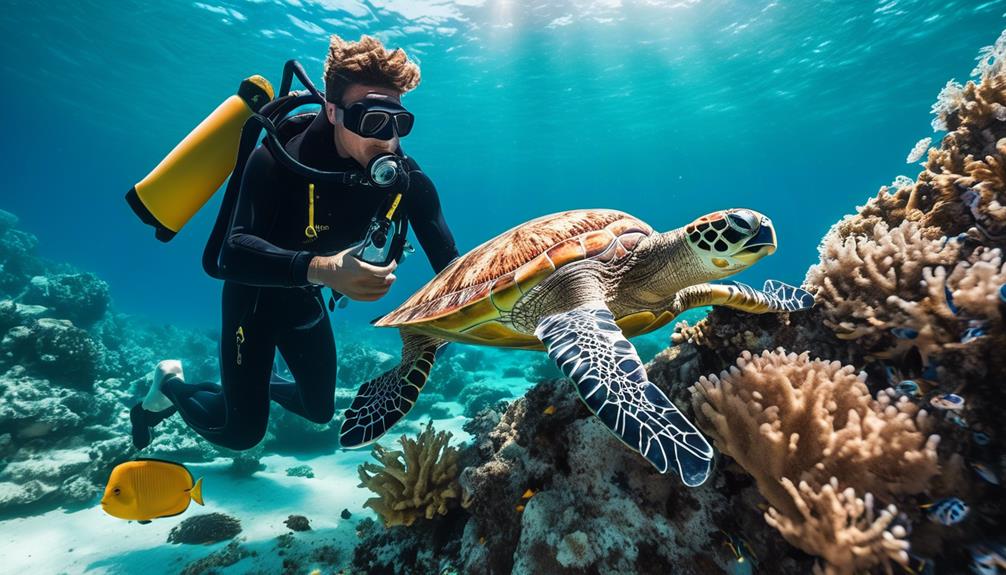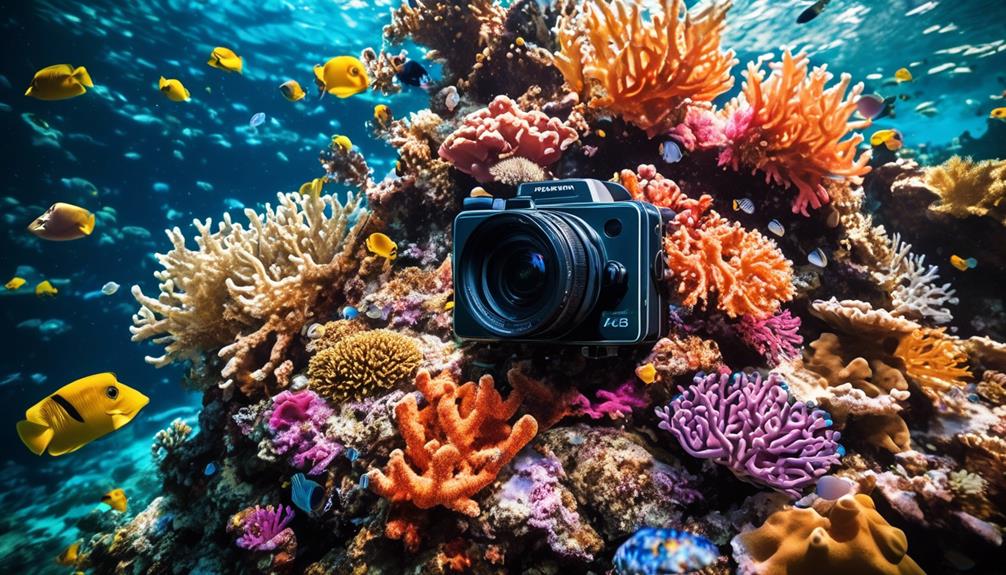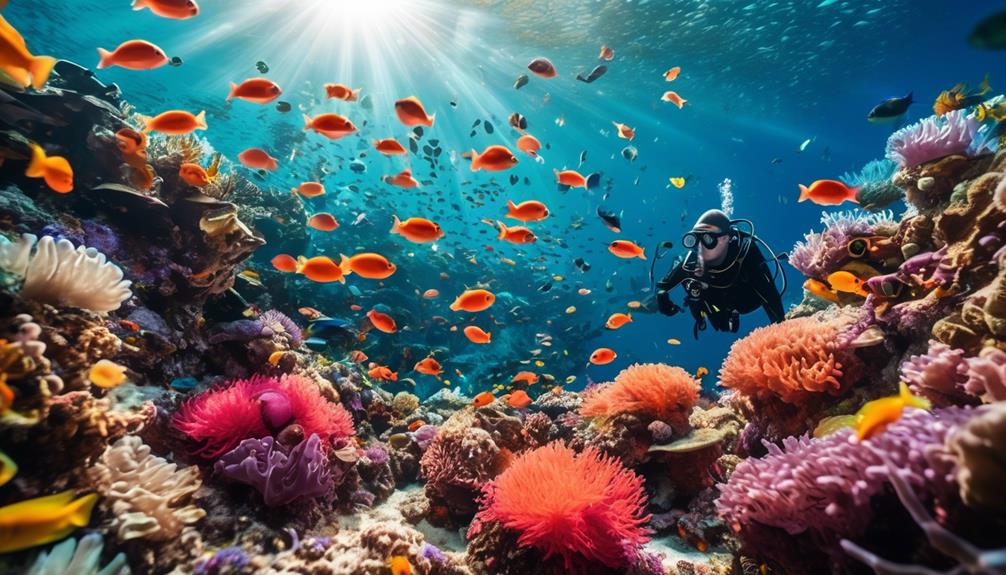Please note this post may contain affiliate links picked by me (Jay) that I have deemed may be of interest or relevant to you the reader of this.
These links do not affect the cost of the thing if you decide to purchase but i may get a little money if you choose to purchase.
For more information on my affiliate link policy click here.
Diving into the world of underwater marine photography is like diving into an endless ocean of possibilities. As the saying goes, a picture is worth a thousand words, but beneath the surface lies a realm waiting to be captured in all its vibrant glory.
So, if you're ready to take the plunge and immerse yourself in the captivating world of underwater photography, I've got seven invaluable tips that will help you navigate the depths with confidence and capture stunning images that will leave your viewers in awe.
Get ready to unlock the secrets of gear essentials, lighting techniques, composition mastery, and much more.
Are you ready to dive in?
Key Takeaways
- Investing in quality gear, such as macro lenses and underwater housings, is essential for enhancing the underwater photography experience.
- Understanding lighting techniques, both natural and artificial, is crucial for capturing vibrant colors and details in underwater photographs.
- Mastering composition techniques, such as the rule of thirds and leading lines, adds depth and visual interest to underwater images.
- Knowing the right settings, including exposure, filters, and white balance, is important for capturing stunning underwater photographs.
Gear Essentials
When it comes to capturing stunning underwater photographs, having the right gear is absolutely essential. As a passionate underwater photographer, I understand the importance of investing in quality equipment to achieve the best results.
Two gear essentials that every underwater photographer should have in their arsenal are macro lenses and underwater housings.
Macro lenses are specifically designed to capture close-up shots of small subjects, allowing you to capture the intricate details of marine life. These lenses have a short minimum focusing distance, enabling you to get up close and personal with your subject without disturbing them. With a macro lens, you can capture the vibrant colors and textures of coral reefs, the delicate patterns of seashells, or the intricate designs of tiny fish.
Equally important is an underwater housing, which is a protective case that houses your camera and keeps it safe from water damage. These housings are specifically designed to be waterproof, allowing you to submerge your camera and capture breathtaking images underwater. They also provide access to all the essential camera controls, ensuring that you have full control over your settings while underwater.
Investing in high-quality macro lenses and underwater housings will greatly enhance your underwater photography experience. These gear essentials will allow you to capture stunning images that showcase the beauty and diversity of the underwater world.
Understanding Lighting
As an underwater photographer, I've come to appreciate the profound impact that lighting can have on capturing the true essence and beauty of the marine world. The way light interacts with the underwater environment creates a magical and ethereal atmosphere that can elevate your photographs to a whole new level.
Here are some key points to consider when it comes to understanding lighting in underwater photography:
- Natural Light: Harnessing the power of natural light is essential in creating stunning underwater images. The way sunlight filters through the water can create mesmerizing patterns and colors, adding depth and dimension to your photographs.
- Artificial Lighting: Using artificial lighting, such as strobes or video lights, allows you to bring out the true colors and details of your subject. By carefully positioning your lights, you can create dramatic and captivating images that showcase the beauty of the underwater world.
- Lighting Techniques: Experimenting with different lighting techniques, such as backlighting or side lighting, can help you create unique and visually striking images. Don't be afraid to play with shadows and highlights to add depth and drama to your photographs.
- Underwater Photography Equipment: Investing in high-quality underwater photography equipment, such as underwater housings and strobes, is crucial for achieving professional results. Make sure to research and choose gear that's specifically designed for underwater use to ensure optimal performance.
Understanding lighting is essential in underwater photography. By mastering the art of lighting, you can capture the true essence and beauty of the marine world, creating images that evoke emotion and inspire awe. So dive in, explore the depths, and let the magic of light guide you on your underwater photography journey.
Mastering Composition
Mastering composition is the key to creating visually captivating and impactful underwater photographs that tell a story and draw viewers into the mesmerizing world beneath the waves. Underwater environments offer a unique and stunning backdrop for photography, and understanding how to compose your shots effectively can take your images to the next level.
When it comes to composition, there are a few creative techniques that can greatly enhance your underwater photographs. One technique is the rule of thirds, where you divide your frame into nine equal parts using two horizontal and two vertical lines. By placing your subject along these lines or at their intersections, you create a more visually interesting and balanced composition.
Another technique is using leading lines to guide the viewer's eye through the image. Underwater, these leading lines can be created by the natural curves of coral reefs, the sleek bodies of fish, or even the patterns on the ocean floor. By incorporating these lines into your composition, you add depth and dimension to your photograph.
Additionally, paying attention to the foreground and background can make a significant difference in your underwater images. Including interesting elements in the foreground, such as vibrant coral or a school of fish, can add depth and create a sense of scale. Meanwhile, the background can provide context and help tell the story of the underwater environment you're capturing.
Mastering composition in underwater photography requires practice, experimentation, and a keen eye for detail. By implementing these creative techniques and exploring different perspectives, you can create visually stunning images that captivate your audience and showcase the mesmerizing beauty of the underwater world.
Choosing the Right Settings
To capture breathtaking underwater photographs, it's crucial to have a deep understanding of the right settings to use. Understanding exposure and using filters are two key elements that can elevate your underwater photography game to new heights. Let me share with you some tips that will revolutionize the way you approach your settings:
- Mastering exposure: Underwater environments present unique lighting challenges, making exposure crucial for capturing stunning images. Experiment with different aperture, shutter speed, and ISO settings to find the perfect balance between capturing details and avoiding overexposure.
- Using filters: Filters are indispensable tools for underwater photography. A red filter can enhance the warm tones and bring out the vibrant colors of the marine life, while a polarizing filter can reduce glare and enhance the clarity of the water. Don't underestimate the power of these small accessories to transform your images.
- White balance: Adjusting the white balance settings can have a dramatic impact on the overall mood of your underwater photographs. Play around with different white balance presets or manually set the white balance to capture the true colors of the underwater world.
- Customizing settings: Every underwater photography situation is unique, so don't be afraid to customize your settings to suit the specific conditions you're shooting in. Experiment with different settings to achieve the desired outcome and let your creativity soar.
Capturing Marine Life Behavior
When capturing marine life behavior, immerse yourself in their world and let their captivating actions tell a story of life beneath the waves. As an underwater photographer, I've had the privilege of witnessing incredible marine life interactions and capturing them through my lens.
To capture these precious moments, it's essential to master a few underwater photography techniques.
Firstly, it's crucial to understand the behavior of the marine creatures you're photographing. Spend time observing and studying their habits, as this knowledge will help you anticipate their actions and capture them at the perfect moment. Patience is key in underwater photography, as marine life can be unpredictable.
Secondly, lighting plays a vital role in capturing the beauty of marine life. Use natural light whenever possible, as it will bring out the vibrant colors and details of the underwater world. Experiment with different angles and positions to find the best lighting that highlights the subject and creates a visually stunning image.
Lastly, composition is essential in telling the story of marine life behavior. Consider the rule of thirds and leading lines to create a visually appealing image. Pay attention to the background and foreground to create depth and add interest to your photographs.
Exploring Different Angles
As an underwater photographer, I'm constantly amazed by the endless possibilities and captivating beauty that can be captured when exploring different angles beneath the waves. The underwater world is a realm of wonder, where every turn reveals a new perspective and a unique story to be told. With the right underwater camera and creative techniques, you can unlock a whole new world of possibilities and create stunning images that truly stand out.
Here are four ways to explore different angles and elevate your underwater photography:
- Shoot from below: By shooting upwards towards the surface, you can capture the mesmerizing play of light and shadow, creating a dramatic and ethereal effect.
- Get close and personal: Dive in close to your subjects to capture intricate details and vibrant colors. This allows you to showcase the intricate patterns, textures, and behaviors of marine life in a way that's both intimate and captivating.
- Experiment with different perspectives: Try shooting from unusual angles or from below the subject to create a sense of depth and dimension. This adds visual interest and brings a fresh perspective to your images.
- Embrace negative space: Don't be afraid to leave empty space in your frame. By using negative space strategically, you can draw attention to your subject and create a sense of balance and harmony in your composition.
Post-Processing Techniques
I love diving into the world of post-processing techniques, where I can take my already captivating underwater images and transform them into true works of art. Through color correction and the removal of backscatter, I can enhance the vibrancy and clarity of my photographs, bringing out the true beauty of the underwater world.
Color correction is an essential step in post-processing. Underwater, the colors can appear dull and washed out due to the water's natural filtering effect. By adjusting the white balance and saturation levels, I can restore the true colors of the scene, making the blues more vibrant and the reds more vivid.
Removing backscatter is another crucial technique in underwater photography. Backscatter refers to the tiny particles and debris suspended in the water that can appear as unwanted specks in the image. Using software tools like clone stamp or healing brush, I can easily remove these distractions, resulting in a cleaner and more visually appealing photograph.
Here's a quick reference table to summarize the post-processing techniques for underwater photography:
| Technique | Description |
|---|---|
| Color Correction | Adjusting white balance and saturation levels |
| Removing Backscatter | Removing unwanted specks and particles in the image |
Frequently Asked Questions
How Can I Protect My Camera and Equipment From Water Damage While Shooting Underwater?
To protect my camera and equipment from water damage while shooting underwater, I rely on waterproof camera cases and lens filters for underwater photography. These essential tools ensure that my gear stays safe and secure, allowing me to capture breathtaking images beneath the surface.
With the right equipment, I can explore the beauty of the underwater world without worrying about damaging my camera. It's a game-changer for any underwater photography enthusiast looking to push the boundaries of innovation.
What Are Some Tips for Dealing With Low Visibility Conditions While Underwater Photography?
When it comes to dealing with low visibility conditions in underwater photography, there are a few tips that can greatly improve your results.
First, investing in powerful underwater lighting equipment is essential for illuminating your subjects.
Additionally, choosing the right camera settings, such as a higher ISO and wider aperture, can help capture more light in challenging conditions.
With these techniques, you'll be able to capture stunning underwater images even in low visibility.
Are There Any Specific Techniques for Capturing Fast-Moving Marine Animals?
When it comes to capturing fast-moving marine animals, there are a few techniques that can help you get the shot.
One effective method is using tracking techniques to anticipate the animal's movements and adjust your camera accordingly.
Another useful tool is burst mode, which allows you to take multiple shots in rapid succession, increasing your chances of capturing the perfect moment.
How Can I Achieve Sharp Focus in My Underwater Images?
To achieve sharp focus in my underwater images, I make sure to properly expose my shots and understand white balance. It's essential to have the right exposure settings to capture the details and colors accurately.
Additionally, understanding white balance helps me achieve accurate color reproduction, making my images vibrant and lifelike.
What Are Some Common Mistakes to Avoid When Editing and Post-Processing Underwater Photos?
When it comes to editing and post-processing underwater photos, there are some common mistakes that beginners should avoid.
One of the most important things to keep in mind isn't to overdo it with filters and effects. It's easy to get carried away, but subtlety is key in enhancing the natural beauty of marine life.
Additionally, be mindful of color correction and white balance to ensure accurate representation of the underwater world.
Taking the time to learn these post-processing tips will greatly improve your underwater photography skills.
Conclusion
As I swim through the depths of the ocean, camera in hand, I can't help but feel a sense of wonder and awe.
Underwater marine photography isn't just about capturing stunning images, but about immersing yourself in a whole new world.
With the right gear, understanding of lighting, and mastery of composition, you can uncover the beauty that lies beneath the waves.
So dive in, explore different angles, and let your photographs tell the captivating stories of marine life.


